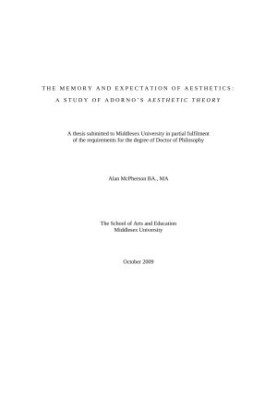The Memory and Expectation of Aesthetics. A Study of Adorno's Aesthetic Theory
 Instant download
Instant download
after payment (24/7)
 Wide range of formats
Wide range of formats
(for all gadgets)
 Full book
Full book
(including for Apple and Android)
This study aims to clarify the underlying conceptual structure of Adorno‟s theoreticalposition with regard to both philosophy and art and to examine the expectation ofphilosophical aesthetics. I introduceAesthetic Theoryfrom a morphological point of viewand claim that the form and structure of this unfinished text reveals a great deal about thebook, as it exemplifies Adorno‟s theory of meaning. I claim that for Adorno dialectic isbetter thought of not in its Hegelian form but as a Kantian antinomy. This is because thedialectical oppositions he identifies cannot be resolved under the capitalist conditions ofthe administered world. I claim that philosophy understood as the construction of a formof totality, the constellation, provides the key to understanding Adorno‟s theory ofmeaning. This theory consists of three linked concepts: midpoint, constellation andparataxis. I further claim that for Adorno art and philosophy are structured in the sameway. Adorno has in effect developed a conception of art that depends for its ultimatejustification on the concept of rank as explicated by the completion of the work of art byphilosophy. Art and theory are thus entwined in a mimetic relationship.I claim there is atemporal dichotomy at the centre of Adorno‟s conception of the work of art, that it is bothtransient and absolute. This antinomy is what makes the work of art a paradoxicallyabsolute commodity precisely because Adorno‟s concept of the work of art is modelledon the commodity form. I claim that Adorno‟s conception of the artwork as an instant isclearly closely related, in a structural and conceptual sense, to his conception of howphilosophy works. Truth for Adorno is always located in the present instant. My textualanalysis leads me to claim that for Adorno a utopian element is involved in writing anegative dialectical text.Finally, I claim that a theory of the art form in all its differenttypologies is best suited to carry out detailed critique and theoretical reflection oncontemporary art. Philosophical aesthetics can only supply an historical perspective.
LF/920882/R
Data sheet
- Name of the Author
- Alan McPherson BA.
MA - Language
- English
- Release date
- 2009


























